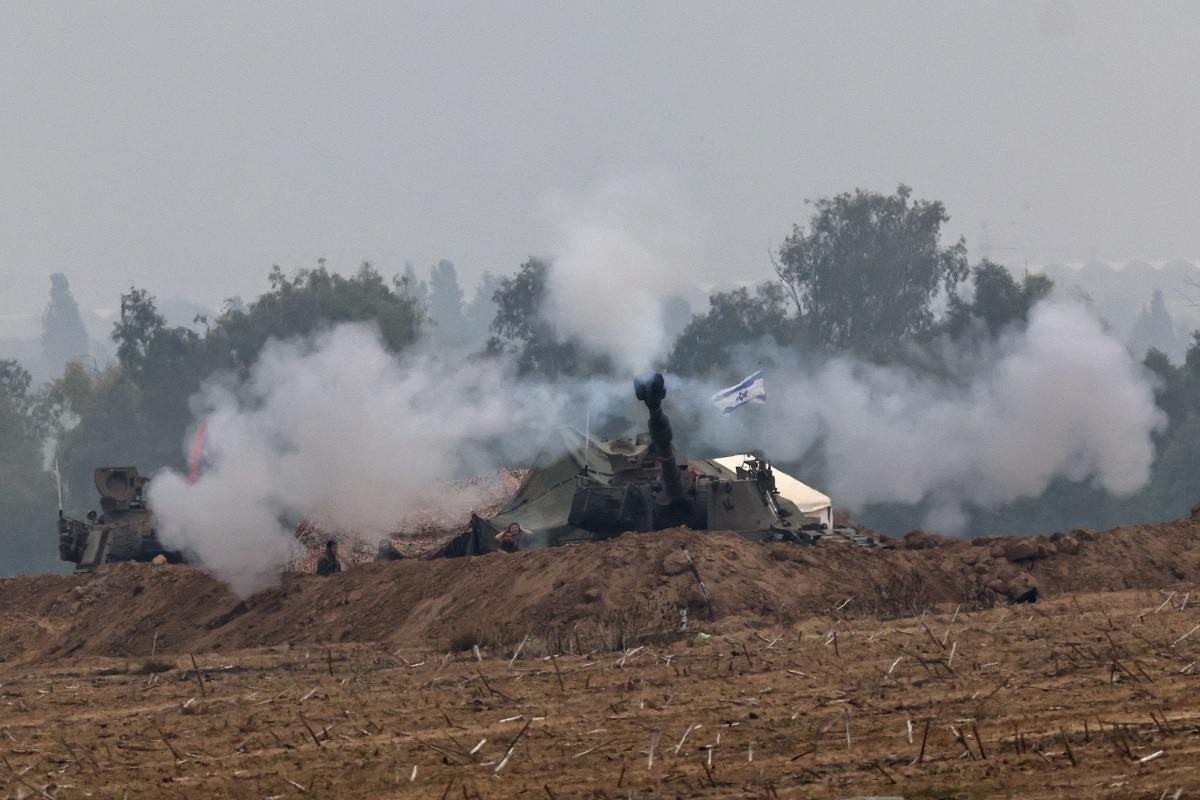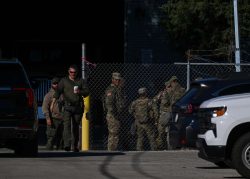
An Israeli artillery unit operates at the border with Gaza, amid the ongoing conflict between Israel and the Palestinian Islamist group Hamas, as seen from southern Israel, December 5, 2023.
13:23 JST, December 6, 2023
TEL AVIV – As Israel opens a new southern front in its war in Gaza, it is still far from achieving its stated military objective: the total destruction of the Hamas militant group that rules the enclave and spearheaded the Oct. 7 attack on southern Israel.
At least 5,000 Hamas militants have been killed, according to three Israeli security officials, leaving the majority of the group’s estimated 30,000-strong military wing intact.
The Israeli officials spoke to The Washington Post on the condition of anonymity to discuss ongoing military operations and details that have not been made public.
Operations in the north are far from complete. Though much of Gaza City has been leveled by airstrikes, ground forces have yet to enter some of Hamas’s key strongholds there.
“This is going to be a long haul,” said Lt. Col. Richard Hecht, a spokesman for the Israeli military. “We need the time,” he added, acknowledging the diplomatic clock was ticking.
International pressure to minimize civilians deaths is likely to influence the pace of operations in the south, as Israel tries to maintain the support of the United States, its key backer.
The cost has already been devastating, with nearly 16,000 Palestinians killed, including more than 5,000 children, according to Gaza’s Ministry of Health.
“I think we have reached a moment when the Israeli authorities will have to define more clearly what their final objective is,” French President Emmanuel Macron said Monday. “The total destruction of Hamas? Does anybody think that’s possible? If it’s that, the war will last 10 years.”
Territory
About a third of Gaza City is still out of the control of Israeli forces, including some areas that are expected to be heavily fortified, said Michael Milshtein, former head of the Palestinian department in Israel’s military intelligence agency.
During the recent pause in fighting, dozens of armed, balaclava-clad militants appeared in a main square to hand over hostages, pointing to the group’s continued presence in what was once the enclave’s largest city.
The Israeli military has so far skirted Hamas’s known military strongholds there, including Shejaiya – where some of the most intense battles of Operation Cast Lead took place in 2014, and where Hamas probably has dug in for a fight.
“It will be very tough,” Milshtein said of the potential battle in the area, adding that Hamas “really prepared all their infrastructure.”
Satellite imagery taken by Planet Labs on Thursday – just before the end of the temporary pause in fighting – showed little sign of an Israeli military presence around the neighborhoods of Shejaiya or Jabalya, another neighborhood in the east.
But the areas have been the focus of heavy bombardment and raids since the return to fighting late last week. “This is a final announcement: You are all targets,” Avichay Adraee, the IDF’s Arabic-language spokesperson, posted Sunday on X, addressing militants in Shejaiya.
The IDF said it conducted a raid in Jabalya on Monday after “completing the encirclement” of the local refugee camp.
“The deadliest battle may be ahead of us,” said Michael A. Horowitz, head of intelligence at risk consultancy Le Beck International. Hamas appears to have avoided direct confrontations so far, he said, but “they are going to be cornered and they are going to have to fight.”
Though Israel is currently pounding the south with airstrikes and casualties are climbing, international pressure will make it hard for the IDF to replicate its northern strategy over the long term, he said, with the campaign more likely to focus on raids and counterinsurgency operations. “Most likely there’s going to be some form of a lower-level counterinsurgency campaign for the coming months,” he said.
An Israeli security official echoed that assessment: “Our operations will be very different to how we’ve operated in Gaza City, because it is much more overcrowded,” they said.
Fighters
The Israeli security officials acknowledge the 5,000 figure provided for dead fighters is only an estimate.
“We’re working on the intelligence, analyzing it and understanding how many and where they were killed,” one of the officials said.
The count is complicated by the fact that many militants are believed to have been killed underground in tunnels. Israeli estimates are based in part on intercepts of Hamas’s own assessments, the official added.
Hamas officials have not released figures for their war dead and declined to comment for this article. “We only have one source, and that’s the IDF who are interested to, in many ways, to up the numbers,” Horowitz said.
Hamas is believed to have anywhere between 27,000 and 40,000 fighters, and analysts say it has easy access to recruits.
But the overall number of foot soldiers is less important to Israel than decapitating Hamas’s leadership, particularly Yehiya Sinwar, the Hamas chief in Gaza whom the Israeli military has described as a “dead man walking.”
“They are the ones who are their symbols; they’re the ones who have the authority to rule the Strip,” said Eyal Hulata, the head of Israel’s National Security Council until earlier this year. “So that’s the main operational goal at the moment, and they’ve all fled to the south, that’s very clear.”
The Israeli military has dedicated large amounts of intelligence manpower to pinpointing the whereabouts of Sinwar, as well as other key leaders such as Mohammed Deif, the head of Hamas’s military wing.
“This war can change in forms, it can be different levels of intensity, but we will continue to conduct it until we get them,” Hulata said.
Tunnels
Hamas is believed to have hundreds of miles of tunnels that snake under Gaza, and they are among its most vital military assets, allowing the group to transport weapons and fighters undetected.
“One of the goals is to get where the tunnels are,” said Horowitz, noting that the underground network cannot be easily fixed or replaced in the middle of a conflict.
Military officials have put the number of tunnel shafts discovered so far at 800, with 500 already destroyed. They have declined to comment on reports that a plan is being considered to use pumps to flood the tunnels with seawater.
It’s difficult to gauge how much of an impact Israel has been able to make on the tunnel system as a whole, said Horowitz. “We don’t know how many shafts there are for each tunnel,” he said.
While some may be small, intended for one-off attacks, others are thought to be dozens of meters deep and connected to larger networks. Horowitz’s firm estimates that about a third of Gaza’s tunnel system remains intact.
Rockets
Despite two months of intense fighting, Hamas remains capable of firing rockets toward Israel. Several barrages were unleashed toward southern Israel on Tuesday, with one hitting a residential building in the city of Ashkelon.
Still, sirens in more distant cities, such as Tel Aviv, have been rare in recent weeks, and the number of rockets fired from Gaza has dropped from thousands in the first hours of the war to dozens a day. The country’s Iron Dome air defense system ensures the vast majority of rockets are intercepted.
“There’s been a real decrease,” said Horowitz. “The question is why. It could be that Israel is really striking Hamas very hard and that the rocket arsenal of Hamas is decreasing very significantly. But it could be that Hamas is also pacing itself.”
Before the war, Israeli intelligence estimated that Hamas and other Palestinian factions in Gaza had an arsenal of about 30,000 rockets. Israeli authorities say militants have fired more than 11,500 toward Israel since Oct. 7.
It will be difficult for Israel to completely destroy Hamas’s rocket capabilities, Horowitz said, as many are produced locally.
“You need to actually go and find the rocket making factories and disrupt the flow of material. It really takes a long time. To really have a day where Hamas can fire zero rockets toward Israel, that’s a day that’s difficult to achieve.”
"News Services" POPULAR ARTICLE
-

American Playwright Jeremy O. Harris Arrested in Japan on Alleged Drug Smuggling
-

Japan’s Nikkei Stock Average as JGB Yields, Yen Rise on Rate-Hike Bets
-

Japan’s Nikkei Stock Average Licks Wounds after Selloff Sparked by BOJ Hike Bets (UPDATE 1)
-

Japan’s Nikkei Stock Average Buoyed by Stable Yen; SoftBank’s Slide Caps Gains (UPDATE 1)
-

Japanese Bond Yields Zoom, Stocks Slide as Rate Hike Looms
JN ACCESS RANKING
-

Tokyo Economic Security Forum to Hold Inaugural Meeting Amid Tense Global Environment
-

Keidanren Chairman Yoshinobu Tsutsui Visits Kashiwazaki-Kariwa Nuclear Power Plant; Inspects New Emergency Safety System
-

Imports of Rare Earths from China Facing Delays, May Be Caused by Deterioration of Japan-China Relations
-

University of Tokyo Professor Discusses Japanese Economic Security in Interview Ahead of Forum
-

Japan Pulls out of Vietnam Nuclear Project, Complicating Hanoi’s Power Plans
























